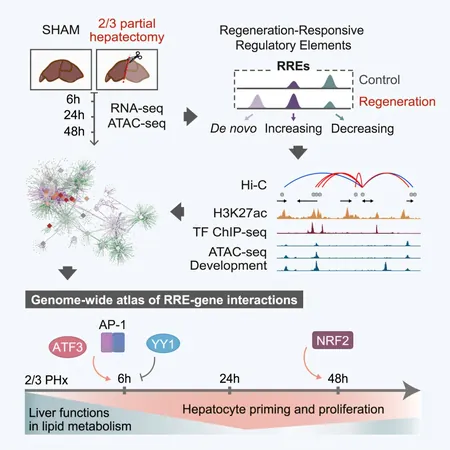
Unlocking the Secrets of Liver Regeneration: Key Discoveries from Genetic Research
2025-06-03
Author: Wei Ling
A Breakthrough in Understanding Liver Regeneration
The mammalian liver possesses an incredible ability to regenerate, fully restoring its mass and function after damage or partial removal. In a groundbreaking study led by researchers at the University of Barcelona, scientists have pinpointed the genetic regions that trigger this regeneration.
Published in the prestigious journal Cell Genomics, this research offers a comprehensive genome-wide map detailing how regulatory elements interact with crucial genes responsible for liver regeneration. These findings not only deepen our understanding of the regeneration process but also pave the way for advancements in regenerative medicine.
A Collaborative Effort in Genetic Research
The research team, including first author Palmira Llorens-Giralt and professors Florenci Serras and Montserrat Corominas, hails from the Department of Genetics, Microbiology, and Statistics, as well as the Institute of Biomedicine at the University of Barcelona. They collaborated with esteemed researchers from various institutes, including the Bellvitge Biomedical Research Institute and the Center for Genomic Regulation.
Revealing the Inner Workings of Liver Restoration
By studying mouse livers after partial organ resection, the team analyzed chromatin changes that play a vital role in regulating gene expression during regeneration. According to Corominas, understanding this process is crucial for enhancing clinical strategies, especially in liver surgeries and transplants.
Drawing Parallels with Embryonic Liver Development
The study offers insights that link liver regeneration with embryonic liver development. Researchers discovered that the expression of essential genes is orchestrated by a diverse array of regulatory elements, including both unique regeneration-specific enhancers and reactivated developmental enhancers. This strategy reactsivate cellular processes that are pivotal for the proliferation of hepatocytes, the primary cells in the liver.
The Tightrope of Regeneration and Metabolism
Interestingly, the study reveals that liver regeneration suppresses enhancers related to specific metabolic functions, especially those involved in fat and lipid metabolism. Llorens-Giralt noted, 'This indicates that regeneration is meticulously controlled, prioritizing proliferation while temporarily inhibiting energy-intensive metabolic processes like bile acid synthesis.'
Identifying Key Players in the Regenerative Process
Researchers also identified critical transcriptional regulators that orchestrate liver regeneration. Initially, complexes like AP-1 and ATF3 activate the enhancers necessary for dormant hepatocytes to re-enter the cell cycle and start proliferating. Later on, NRF2 takes center stage, guiding the regulatory process as these transcription factors communicate the cellular responses necessary for regeneration.
Laying the Foundation for Future Medical Innovations
This study stands out by providing a detailed map of enhancer-gene interactions and identifying vital regulators of early liver regeneration. While the research aims at foundational understanding without immediate clinical applications, it holds potential for groundbreaking advancements in regenerative medicine.
The researchers believe that this profound understanding can lay the groundwork for future medical innovations, potentially leading to therapies that activate specific enhancers or modulate regenerative responses. This work could serve as a crucial bridge connecting basic research to tangible medical solutions.

 Brasil (PT)
Brasil (PT)
 Canada (EN)
Canada (EN)
 Chile (ES)
Chile (ES)
 Česko (CS)
Česko (CS)
 대한민국 (KO)
대한민국 (KO)
 España (ES)
España (ES)
 France (FR)
France (FR)
 Hong Kong (EN)
Hong Kong (EN)
 Italia (IT)
Italia (IT)
 日本 (JA)
日本 (JA)
 Magyarország (HU)
Magyarország (HU)
 Norge (NO)
Norge (NO)
 Polska (PL)
Polska (PL)
 Schweiz (DE)
Schweiz (DE)
 Singapore (EN)
Singapore (EN)
 Sverige (SV)
Sverige (SV)
 Suomi (FI)
Suomi (FI)
 Türkiye (TR)
Türkiye (TR)
 الإمارات العربية المتحدة (AR)
الإمارات العربية المتحدة (AR)